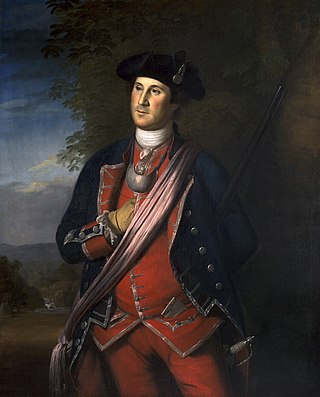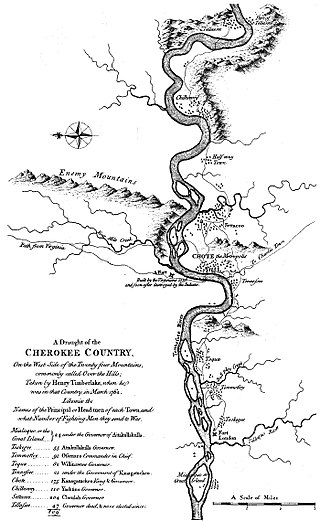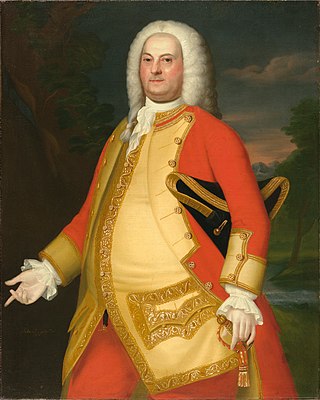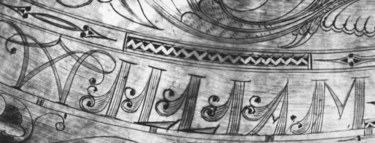Richard Gridley was born in Boston, Massachusetts. He was a soldier and engineer who served for the British Army during the French and Indian Wars and for the Continental Army during the American Revolutionary War.

The 1759 Battle of Ticonderoga was a minor confrontation at Fort Carillon on July 26 and 27, 1759, during the French and Indian War. A British military force of more than 11,000 men under the command of General Sir Jeffery Amherst moved artillery to high ground overlooking the fort, which was defended by a garrison of 400 Frenchmen under the command of Brigadier General François-Charles de Bourlamaque.

Kittanning was an 18th-century Native American village in the Ohio Country, located on the Allegheny River at present-day Kittanning, Pennsylvania. The village was at the western terminus of the Kittanning Path, an Indian trail that provided a route across the Alleghenies between the Ohio and Susquehanna river basins.

The Powder Alarm was a major popular reaction to the removal of gunpowder from a magazine near Boston by British soldiers under orders from General Thomas Gage, royal governor of the Province of Massachusetts Bay, on September 1, 1774. In response to this action, amid rumors that blood had been shed, alarm spread through the countryside to Connecticut and beyond, and American Patriots sprang into action, fearing that war was at hand. Thousands of militiamen began streaming toward Boston and Cambridge, and mob action forced Loyalists and some government officials to flee to the protection of the British Army.

The Virginia militia is an armed force composed of all citizens of the Commonwealth of Virginia capable of bearing arms. The Virginia militia was established in 1607 as part of the English militia system. Militia service in Virginia was compulsory for all free males. The main purpose of the Crown's militia was to repel invasions and insurrections and to enforce the laws of the colony.

The siege of Fort William Henry was conducted by a French and Indian force led by Louis-Joseph de Montcalm against the British-held Fort William Henry. The fort, located at the southern end of Lake George, on the frontier between the British Province of New York and the French Province of Canada, was garrisoned by a poorly supported force of British regulars and provincial militia led by Lieutenant Colonel George Monro.
The New Hampshire Militia was first organized in 1631 and lasted until 1641, when the area came under the jurisdiction of Massachusetts. After New Hampshire became an separate colony again in 1679, New Hampshire Colonial Governor John Cutt reorganized the militia on March 16, 1680, with one foot company apiece for the four major settlements in Portsmouth, Dover, Exeter and Hampton, and an artillery and cavalry company in Portsmouth. The King of England authorized the Provincial Governor to give commissions to persons who shall be best qualified for regulating and discipline of the militia. President Cutt placed Major Richard Waldron of Dover in command of the Militia. In 1879, the Militia was designated by the state as the New Hampshire National Guard.
Nathan Whiting was a soldier and merchant in Colonial America.

The Battles of Lexington and Concord, also called the Shot Heard 'Round the World, were the first military engagements of the American Revolutionary War. The battles were fought on April 19, 1775, in Middlesex County, Province of Massachusetts Bay, within the towns of Lexington, Concord, Lincoln, Menotomy, and Cambridge. They marked the outbreak of armed conflict between the Kingdom of Great Britain and Patriot militias from America's thirteen colonies.
Barzillai Lew was an African-American soldier who served with distinction during the American Revolutionary War.

Colonial American military history is the military record of the Thirteen Colonies from their founding to the American Revolution in 1775.

Minutemen were members of the organized New England colonial militia companies trained in weaponry, tactics, and military strategies during the American Revolutionary War. They were known for being ready at a minute's notice, hence the name. Minutemen provided a highly mobile, rapidly deployed force that enabled the colonies to respond immediately to military threats. They were an evolution from the prior colonial rapid-response units.

The siege of Fort Loudoun was an engagement during the Anglo-Cherokee War fought from February 1760 to August 1760 between the warriors of the Cherokee led by Ostenaco and the garrison of Fort Loudoun composed of British and colonial soldiers commanded by Captain Paul Demeré.

Silvanus Cobb was a Massachusetts provincial army captain and later naval commander who fought for the British primarily in Nova Scotia in the 1740s and 1750s.
Gorham's Rangers was one of the most famous and effective ranger units raised in colonial North America. Formed by John Gorham, the unit served as the prototype for many subsequent ranger forces, including the better known Rogers' Rangers. The unit started out as a Massachusetts provincial auxiliary company, which means it was not part of the province's normal militia system. Recruited in the summer of 1744 at the start of King George's War, Governor William Shirley ordered the unit raised as reinforcements for the then-besieged British garrison at Fort Anne in Annapolis Royal. The unit was primarily used to secure British control in Nova Scotia, whose population consisted primarily of hostile Acadian and Mi'kmaq. Initially a sixty-man all-Indian company led by British officers, the original Native American members of the unit were gradually replaced by Anglo-Americans and recent Scots and Irish immigrants and were a minority in the unit by the mid-1750s. The company were reconnaissance experts as well as renowned for their expertise at both water-borne operations and frontier guerrilla warfare. They were known for surprise amphibious raids on Acadian and Mi'kmaq coastal or riverine settlements, using large whaleboats, which carried between ten and fifteen rangers each. This small unit was the main British military force defending Nova Scotia from 1744 to 1749. The company became part of the British Army and was expanded during the Seven Years' War and went on to play an important role in fighting in Nova Scotia as well as participating in many of the important campaigns of the war, particularly distinguishing itself at the Siege of Quebec in 1759.

Fort Dobbs was an 18th-century fort in the Yadkin–Pee Dee River Basin region of the Province of North Carolina, near what is now Statesville in Iredell County. Used for frontier defense during and after the French and Indian War, the fort was built to protect the American settlers of the western portion of what was then Rowan County, and served as a vital outpost for soldiers, traders, and colonial officials. Fort Dobbs' primary structure was a blockhouse with log walls, surrounded by a shallow ditch, and by 1761, a palisade. It was intended to provide protection from French-allied Native Americans such as the Shawnee and Delaware, and French raids into North Carolina.
Danks' Rangers was a ranger unit raised in colonial North America and led by Captain Benoni Danks. It was modeled on and often served alongside of the better known Gorham's Rangers. The unit was recruited in early 1756, during the early stages of the Seven Years' War / French and Indian War, from among men serving in two then-disbanding New England provincial battalions stationed in Nova Scotia. Raised to help protect the British garrison on the Isthmus of Chignecto and secure the area after the siege of Fort Beauséjour, their principle foes were Acadian and Mi'kmaq Indians conducting a low-level insurgency against the British authorities in Nova Scotia. Their primary area of operations was the northwestern portion of Nova Scotia and the north and eastern parts of what would later become New Brunswick. The unit averaged a little over one hundred men for much of its existence, although it seems to have been augmented to 125 for the attack on Havana in 1762. The company often operated in tandem with Gorham's Rangers, based out of Halifax, Nova Scotia, and after 1761, the two companies were combined into a Nova Scotia ranging corps, led by Major Joseph Gorham.
The Burke's Rangers was a company of colonial volunteers organized and led by Major John Burke in Massachusetts just before the French and Indian War. Burke was widely noted for his skill and daring in Indian warfare, and frequently served in campaigns against the Indians. Burke was initially commissioned as an ensign by Governor William Shirley and subsequently commissioned a lieutenant, then a captain. Toward the close of the French and Indian war, in 1760, he was commissioned a major by Governor Thomas Pownall.

Provincial troops were military units raised by colonial governors and legislatures in British North America for extended operations during the French and Indian Wars. The provincial troops differed from the militia, in that they were a full-time military organization conducting extended operations. They differed from the regular British Army in that they were recruited only for one campaign season at the time. These forces were often recruited through a quota system applied to the militia. Officers were appointed by the provincial governments. During the eighteenth century militia service was increasingly seen as a prerogative of the social and economic well-established, while provincial troops came to be recruited from different and less deep-rooted members of the community.

Major-General William Brattle was an American politician, lawyer, cleric, physician and military officer who served as the Attorney General of Massachusetts from 1736 to 1738. Brattle is best known for his role during the American Revolution, in which he initially aligned himself with the Patriot cause before transferring his allegiances towards the Loyalist camp, which led to the eventual downfall of his fortunes.












